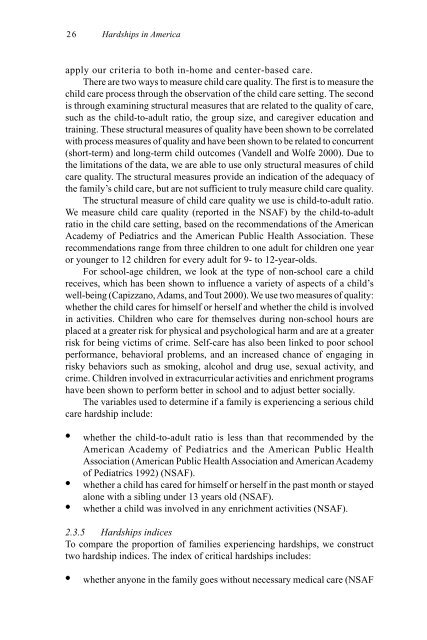You also want an ePaper? Increase the reach of your titles
YUMPU automatically turns print PDFs into web optimized ePapers that Google loves.
26 Hardships in America<br />
apply our criteria to both in-home and center-b<strong>as</strong>ed care.<br />
There are two ways to me<strong>as</strong>ure child care quality. The first is to me<strong>as</strong>ure the<br />
child care process through the observation of the child care setting. The second<br />
is through examining structural me<strong>as</strong>ures that are related to the quality of care,<br />
such <strong>as</strong> the child-to-adult ratio, the group size, and caregiver education and<br />
training. These structural me<strong>as</strong>ures of quality have been shown to be correlated<br />
with process me<strong>as</strong>ures of quality and have been shown to be related to concurrent<br />
(short-term) and long-term child outcomes (Vandell and Wolfe 2000). Due to<br />
the limitations of the data, we are able to use only structural me<strong>as</strong>ures of child<br />
care quality. The structural me<strong>as</strong>ures provide an indication of the adequacy of<br />
the family’s child care, but are not sufficient to truly me<strong>as</strong>ure child care quality.<br />
The structural me<strong>as</strong>ure of child care quality we use is child-to-adult ratio.<br />
We me<strong>as</strong>ure child care quality (reported in the NSAF) by the child-to-adult<br />
ratio in the child care setting, b<strong>as</strong>ed on the recommendations of the American<br />
Academy of Pediatrics and the American Public Health Association. These<br />
recommendations range from three children to one adult for children one year<br />
or younger to 12 children for every adult for 9- to 12-year-olds.<br />
For school-age children, we look at the type of non-school care a child<br />
receives, which h<strong>as</strong> been shown to influence a variety of <strong>as</strong>pects of a child’s<br />
well-being (Capizzano, Adams, and Tout 2000). We use two me<strong>as</strong>ures of quality:<br />
whether the child cares for himself or herself and whether the child is involved<br />
in activities. Children who care for themselves during non-school hours are<br />
placed at a greater risk for physical and psychological harm and are at a greater<br />
risk for being victims of crime. Self-care h<strong>as</strong> also been linked to poor school<br />
performance, behavioral problems, and an incre<strong>as</strong>ed chance of engaging in<br />
risky behaviors such <strong>as</strong> smoking, alcohol and drug use, sexual activity, and<br />
crime. Children involved in extracurricular activities and enrichment programs<br />
have been shown to perform better in school and to adjust better socially.<br />
The variables used to determine if a family is experiencing a serious child<br />
care hardship include:<br />
• whether the child-to-adult ratio is less than that recommended by the<br />
American Academy of Pediatrics and the American Public Health<br />
Association (American Public Health Association and American Academy<br />
of Pediatrics 1992) (NSAF).<br />
• whether a child h<strong>as</strong> cared for himself or herself in the p<strong>as</strong>t month or stayed<br />
alone with a sibling under 13 years old (NSAF).<br />
• whether a child w<strong>as</strong> involved in any enrichment activities (NSAF).<br />
2.3.5 Hardships indices<br />
To compare the proportion of families experiencing hardships, we construct<br />
two hardship indices. The index of critical hardships includes:<br />
• whether anyone in the family goes without necessary medical care (NSAF



